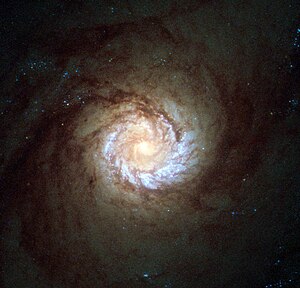| Messier 61[1] | |
|---|---|
 Image taken by Hubble Space Telescope, April 28, 2014[2] Credit: ESA/Hubble & NASA. Acknowledgement: Det58 | |
| Observation data (J2000 epoch) | |
| Constellation | Virgo |
| Right ascension | 12h 21m 54.9s[3] |
| Declination | +04° 28′ 25″[3] |
| Redshift | 0.005224±0.000007[3] |
| Heliocentric radial velocity | 1566±2 km/s[3] |
| Galactocentric velocity | 1483±4 km/s[3] |
| Distance | 52.5 ± 2.3 Mly (16.10 ± 0.71 Mpc) |
| Apparent magnitude (V) | 9.7[4] |
| Characteristics | |
| Type | SAB(rs)bc,[3] HIISy2[3] |
| Apparent size (V) | 6.5 × 5.8 arcmin[3] |
| Other designations | |
| NGC 4303,[3] UGC 07420,[3] PGC 040001,[3] MCG +01-32-022,[3] GC 2878 | |
References: SIMBAD: Search M61 | |
Messier 61 (also known as M61, NGC 4303, or the Swelling Spiral Galaxy) is an intermediate barred spiral galaxy in the Virgo Cluster of galaxies. It was first discovered by Barnaba Oriani on May 5, 1779, six days before Charles Messier discovered the same galaxy. Messier had observed it on the same night as Oriani but had mistaken it for a comet.[5] Its distance has been estimated to be 45.61 million light years from the Milky Way Galaxy. It is a member of the M61 Group of galaxies, which is a member of the Virgo II Groups, a series of galaxies and galaxy clusters strung out from the southern edge of the Virgo Supercluster.[6]
- ^ Tschöke, D.; Hensler, G.; Junkes, N. (2000). "X-rays from the barred galaxy NGC 4303". Astronomy and Astrophysics. 360 (2): 447–456. arXiv:astro-ph/0006361. Bibcode:2000A&A...360..447T.
- ^ "A hungry starburst galaxy". ESA/Hubble Picture of the Week. Retrieved 29 April 2014.
- ^ a b c d e f g h i j k l "NASA/IPAC Extragalactic Database". Results for M 61. Retrieved 2006-11-18.
- ^ "Messier 61". SEDS Messier Catalog. Retrieved 29 April 2022.
- ^ "Messier 61". Archived from the original on 2017-01-06. Retrieved 2017-01-11.
- ^ "The Virgo III Groups". Atlas of the Universe. Retrieved 2010-11-27.